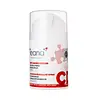What's inside
What's inside
 Key Ingredients
Key Ingredients

 Benefits
Benefits

 Concerns
Concerns

 Ingredients Side-by-side
Ingredients Side-by-side

Water
Skin ConditioningCetearyl Olivate
Sorbitan Olivate
EmulsifyingOlea Europaea Fruit Oil
MaskingCetyl Palmitate
EmollientSorbitan Palmitate
EmulsifyingMatrixyl 3000
Cetyl Hydroxyethylcellulose
Emulsion StabilisingCetearyl Alcohol
EmollientSilicone Quaternium-16
Skin ConditioningUndeceth-11
EmollientButyloctanol
HumectantUndeceth-5
EmulsifyingGlycerin
HumectantThermus Thermophillus Ferment
Skin ConditioningTheobroma Cacao Seed Butter
EmollientSodium Polyacrylate
AbsorbentParfum
MaskingWater, Cetearyl Olivate, Sorbitan Olivate, Olea Europaea Fruit Oil, Cetyl Palmitate, Sorbitan Palmitate, Matrixyl 3000, Cetyl Hydroxyethylcellulose, Cetearyl Alcohol, Silicone Quaternium-16, Undeceth-11, Butyloctanol, Undeceth-5, Glycerin, Thermus Thermophillus Ferment, Theobroma Cacao Seed Butter, Sodium Polyacrylate, Parfum
Water
Skin ConditioningCitrullus Lanatus Seed Oil
EmollientSqualane
EmollientTriolein
Skin ConditioningMusa Sapientum Leaf Extract
Skin ConditioningGlycerin
HumectantBetaine
HumectantCetearyl Olivate
Butyrospermum Parkii Butter
Skin ConditioningCrambe Abyssinica Seed Oil Phytosterol Esters
EmulsifyingGlyceryl Stearate Se
EmulsifyingJojoba Esters
EmollientSelaginella Lepidophylla Extract
EmollientCetearyl Alcohol
EmollientCetyl Palmitate
EmollientSorbitan Olivate
EmulsifyingNicotiana Benthamiana Hexapeptide-40 Sh-Polypeptide-76
Skin ConditioningButylene Glycol
HumectantSalix Alba Bark Extract
AstringentGenipa Americana Fruit Extract
Skin ConditioningSorbitan Palmitate
EmulsifyingSorbitan Oleate
EmulsifyingXanthan Gum
EmulsifyingCitric Acid
BufferingWater, Citrullus Lanatus Seed Oil, Squalane, Triolein, Musa Sapientum Leaf Extract, Glycerin, Betaine, Cetearyl Olivate, Butyrospermum Parkii Butter, Crambe Abyssinica Seed Oil Phytosterol Esters, Glyceryl Stearate Se, Jojoba Esters, Selaginella Lepidophylla Extract, Cetearyl Alcohol, Cetyl Palmitate, Sorbitan Olivate, Nicotiana Benthamiana Hexapeptide-40 Sh-Polypeptide-76, Butylene Glycol, Salix Alba Bark Extract, Genipa Americana Fruit Extract, Sorbitan Palmitate, Sorbitan Oleate, Xanthan Gum, Citric Acid
 Reviews
Reviews

Ingredients Explained
These ingredients are found in both products.
Ingredients higher up in an ingredient list are typically present in a larger amount.
Cetearyl alcohol is a mixture of two fatty alcohols: cetyl alcohol and stearyl alcohol. It is mainly used as an emulsifier. Emulsifiers help prevent the separation of oils and products. Due to its composition, it can also be used to thicken a product or help create foam.
Cetearyl alcohol is an emollient. Emollients help soothe and hydrate the skin by trapping moisture.
Studies show Cetearyl alcohol is non-toxic and non-irritating. The FDA allows products labeled "alcohol-free" to have fatty alcohols.
This ingredient is usually derived from plant oils such as palm, vegetable, or coconut oils. There is debate on whether this ingredient will cause acne.
Due to the fatty acid base, this ingredient may not be Malassezia folliculitis safe.
Learn more about Cetearyl AlcoholCetearyl Olivate is an emulsifier and texture enhancer. It is derived from the fatty acids of olive oil and Cetearyl alcohol, and is biodegradable.
As an emulsifier, it is used to prevent oils and waters from separating. It can also
Manufacturers use the name Olivem 1000. This ingredient has been found to preserve the natural microbiome of skin. Having a healthy microbiome helps keep our skin healthy and protects against harmful bacteria. This ingredient is grouped with Sorbitan Olivate under the name Olivem 1000.
Learn more about Cetearyl OlivateCetyl Palmitate is a wax-like substance.
It comes from palmitic acid and palmityl alcohol. Cetyl Palmitate may not be safe for Malassezia folliculitis, or fungal-acne.
This ingredient is naturally found in the guava fruit and stony corals.
Learn more about Cetyl PalmitateGlycerin is already naturally found in your skin. It helps moisturize and protect your skin.
A study from 2016 found glycerin to be more effective as a humectant than AHAs and hyaluronic acid.
As a humectant, it helps the skin stay hydrated by pulling moisture to your skin. The low molecular weight of glycerin allows it to pull moisture into the deeper layers of your skin.
Hydrated skin improves your skin barrier; Your skin barrier helps protect against irritants and bacteria.
Glycerin has also been found to have antimicrobial and antiviral properties. Due to these properties, glycerin is often used in wound and burn treatments.
In cosmetics, glycerin is usually derived from plants such as soybean or palm. However, it can also be sourced from animals, such as tallow or animal fat.
This ingredient is organic, colorless, odorless, and non-toxic.
Glycerin is the name for this ingredient in American English. British English uses Glycerol/Glycerine.
Learn more about GlycerinSorbitan Olivate is created from the fatty acids in olive oil and sorbitol.
This ingredient is an oil in water emulsifier. It helps stabilize a product by preventing oils and waters from separating. Sorbitan Olivate also helps hydrate the skin.
Manufacturers sell sorbitan olivate under the name OliveM 1000. OliveM 1000 a multifunctional ingredient. It is self-emulsifying. According to a manufacturer, OliveM 1000 does not disrupt natural skin biome.
Due to its olive oil base, this ingredient may not be fungal-acne safe.
Learn more about Sorbitan OlivateSorbitan Palmitate is an emulsifier.
It is created by reacting sorbitol with palmitic acid.
Water. It's the most common cosmetic ingredient of all. You'll usually see it at the top of ingredient lists, meaning that it makes up the largest part of the product.
So why is it so popular? Water most often acts as a solvent - this means that it helps dissolve other ingredients into the formulation.
You'll also recognize water as that liquid we all need to stay alive. If you see this, drink a glass of water. Stay hydrated!
Learn more about Water